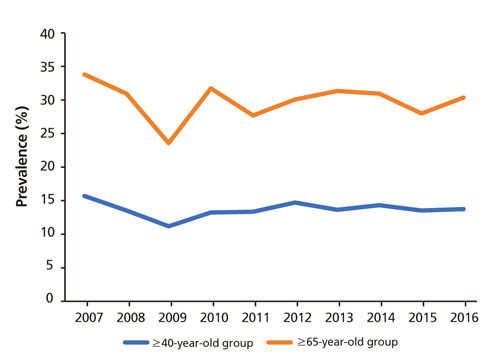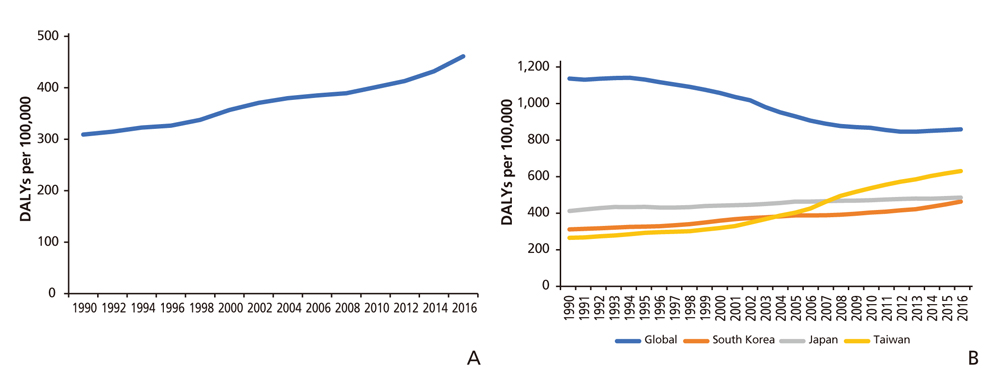J Korean Med Assoc.
2018 Sep;61(9):533-538. 10.5124/jkma.2018.61.9.533.
Prevalence and socioeconomic burden of chronic obstructive pulmonary disease
- Affiliations
-
- 1Division of Pulmonary, Allergy, and Critical Care Medicine, Department of Internal Medicine, Yeouido St. Mary's Hospital, The Catholic University of Korea College of Medicine, Seoul, Korea. cmcyhg@gmail.com
- KMID: 2420363
- DOI: http://doi.org/10.5124/jkma.2018.61.9.533
Abstract
- Chronic obstructive pulmonary disease (COPD) is a common respiratory disease characterized by persistent respiratory symptoms and irreversible airflow obstruction. It is caused by smoking, occupational exposure, and air pollution. It shows a high prevalence, both in South Korea and worldwide. The global COPD prevalence is 11.7%, and a similar prevalence has been reported in South Korea. In the Korea National Health and Nutrition Examination Survey 2010-2016, the prevalence of COPD was found to be between 13.1% to 14.6%. The prevalence of COPD is increasing continuously. Aging, male sex, smoking, and air pollution are risk factors of COPD. However, COPD is strikingly under-recognized given its prevalence. Three million people die annually due to COPD, and the mortality burden of COPD is increasing along with population aging. The socioeconomic burden of COPD is becoming enormous.
Keyword
MeSH Terms
Figure
Reference
-
1. Lopez AD, Shibuya K, Rao C, Mathers CD, Hansell AL, Held LS, Schmid V, Buist S. Chronic obstructive pulmonary disease: current burden and future projections. Eur Respir J. 2006; 27:397–412.
Article2. GBD 2015 Chronic Respiratory Disease Collaborators. Global, regional, and national deaths, prevalence, disability-adjusted life years, and years lived with disability for chronic obstructive pulmonary disease and asthma, 1990-2015: a systematic analysis for the Global Burden of Disease Study 2015. Lancet Respir Med. 2017; 5:691–706.3. Salvi SS, Barnes PJ. Chronic obstructive pulmonary disease in non-smokers. Lancet. 2009; 374:733–743.
Article4. Buist AS, McBurnie MA, Vollmer WM, Gillespie S, Burney P, Mannino DM, Menezes AM, Sullivan SD, Lee TA, Weiss KB, Jensen RL, Marks GB, Gulsvik A, Nizankowska-Mogilnicka E. BOLD Collaborative Research Group. International variation in the prevalence of COPD (the BOLD Study): a population-based prevalence study. Lancet. 2007; 370:741–750.
Article5. Adeloye D, Chua S, Lee C, Basquill C, Papana A, Theodoratou E, Nair H, Gasevic D, Sridhar D, Campbell H, Chan KY, Sheikh A, Rudan I. Global Health Epidemiology Reference Group (GHERG). Global and regional estimates of COPD prevalence: Systematic review and meta-analysis. J Glob Health. 2015; 5:020415.
Article6. Kim DS, Kim YS, Jung KS, Chang JH, Lim CM, Lee JH, Uh ST, Shim JJ, Lew WJ. Korean Academy of Tuberculosis and Respiratory Diseases. Prevalence of chronic obstructive pulmonary disease in Korea: a population-based spirometry survey. Am J Respir Crit Care Med. 2005; 172:842–847.
Article7. Yoo KH, Kim YS, Sheen SS, Park JH, Hwang YI, Kim SH, Yoon HI, Lim SC, Park JY, Park SJ, Seo KH, Kim KU, Oh YM, Lee NY, Kim JS, Oh KW, Kim YT, Park IW, Lee SD, Kim SK, Kim YK, Han SK. Prevalence of chronic obstructive pulmonary disease in Korea: the fourth Korean National Health and Nutrition Examination Survey, 2008. Respirology. 2011; 16:659–665.
Article8. Hwang YI, Park YB, Yoo KH. Recent trends in the prevalence of chronic obstructive pulmonary disease in Korea. Tuberc Respir Dis (Seoul). 2017; 80:226–229.
Article9. Korea Centers for Disease Control and Prevention. Korea health statistics 2016: Korea National Health and Nutrition Examination Survey Source Data (KNHANES VII-1) [Internet]. Cheongju: Korea Centers for Disease Control and Pre-vention;2018. cited 2018 Aug 29. Available from: https://knhanes.cdc.go.kr/knhanes/sub04/sub04_03.do?classType=7.10. Jeon CM. Prevalence of chronic obstructive pulmonary disease among adults over 40 years old in Korea, 2009-2013. Cheongju: Korea Center for Disease Control and Prevention;2015.11. Menezes AM, Perez-Padilla R, Jardim JR, Muino A, Lopez MV, Valdivia G, Montes de Oca M, Talamo C, Hallal PC, Victora CG. PLATINO Team. Chronic obstructive pulmonary disease in five Latin American cities (the PLATINO study): a prevalence study. Lancet. 2005; 366:1875–1881.
Article12. World Health Organization. World health statistics 2018: monitoring health for the SDGs. Geneva: World Health Organization;2018.13. Myong JP, Yoon HK, Rhee CK, Kim HR, Koo JW. Risk factors for lung function impairment among the general non-smoking Korean population. Int J Tuberc Lung Dis. 2015; 19:1019–1026.
Article14. He F, Liao B, Pu J, Li C, Zheng M, Huang L, Zhou Y, Zhao D, Li B, Ran P. Exposure to ambient particulate matter induced COPD in a rat model and a description of the underlying mechanism. Sci Rep. 2017; 7:45666.
Article15. Liu S, Zhou Y, Liu S, Chen X, Zou W, Zhao D, Li X, Pu J, Huang L, Chen J, Li B, Liu S, Ran P. Association between exposure to ambient particulate matter and chronic obstructive pulmonary disease: results from a cross-sectional study in China. Thorax. 2017; 72:788–795.
Article16. Kyung SY, Kim YS, Kim WJ, Park MS, Song JW, Yum H, Yoon HK, Rhee CK, Jeong SH. Guideline for the prevention and management of particulate matter/Asian dust particle-induced adverse health effect on the patients with pulmonary diseases. J Korean Med Assoc. 2015; 58:1060–1069.
Article17. World Health Organization. Top 10 causes of death [Internet]. Geneva: World Health Organization;2016. cited 2018 Aug 29. Available from: http://www.who.int/gho/mortality_burden_disease/causes_death/top_10/en/.18. National Heart Lung, and Blood Institute. Morbidity & mortality: 2009 chartbook on cardiovascular, lung and blood diseases. Bethesda: National Institutes of Health;2009.19. Statistics Korea. Annual report on the cause of death statistics in Korea [Internet]. Daejeon: Statistics Korea;2006. cited 2018 Aug 29. Available from: http://kostat.go.kr/wnsearch/search.jsp.20. Institute for Health Metrics and Evaluation. Global Burden of Disease Study 2016 [Internet]. Seattle: Institute for Health Metrics and Evaluation;2018. cited 2018 Aug 29. Available from: https://vizhub.healthdata.org/gbd-compare/.21. Yoon J, Seo H, Oh IH, Yoon SJ. The non-communicable disease burden in Korea: findings from the 2012 Korean burden of disease study. J Korean Med Sci. 2016; 31:Suppl 2. S158–S167.
Article22. European Respiratory Society. European lung white book. Sheffield: European Respiratory Society;2003.23. Lee J, Lee JH, Kim JA, Rhee CK. Trend of cost and utilization of COPD medication in Korea. Int J Chron Obstruct Pulmon Dis. 2016; 12:27–33.
Article24. Yoo KH, Ahn HR, Park JK, Kim JW, Nam GH, Hong SK, Kim MJ, Ghoshal AG, Muttalif AR, Lin HC, Thanaviratananich S, Bagga S, Faruqi R, Sajjan S, Baidya S, Wang de Y, Cho SH. Burden of respiratory disease in Korea: an observational study on allergic rhinitis, asthma, COPD, and rhinosinusitis. Allergy Asthma Immunol Res. 2016; 8:527–534.
Article25. Yoo KH, Ahn HR, Park JK, Kim JW, Nam GH, Hong SK, Kim MJ, Ghoshal AG, Muttalif AR, Lin HC, Thanaviratananich S, Bagga S, Faruqi R, Sajjan S, Baidya S, Wang de Y, Cho SH. Burden of respiratory disease in Korea: an observational study on allergic rhinitis, asthma, COPD, and rhinosinusitis. Allergy Asthma Immunol Res. 2016; 8:527–534.
Article26. Guarascio AJ, Ray SM, Finch CK, Self TH. The clinical and economic burden of chronic obstructive pulmonary disease in the USA. Clinicoecon Outcomes Res. 2013; 5:235–245.
- Full Text Links
- Actions
-
Cited
- CITED
-
- Close
- Share
- Similar articles
-
- Clinical Year-in-Review of Chronic Obstructive Pulmonary Disease in Korea
- High prevalence of chronic obstructive pulmonary disease in Korea
- Cor Pulmonale with Particular Reference to Chronic Obstructive Pulmonary Disease and Pulmonary Tuberculosis
- The Relationship between Airway Inflammation and Exacerbation in Chronic Obstructive Pulmonary Disease
- Risk Factors of Chronic Obstructive Pulmonary Disease (COPD)




